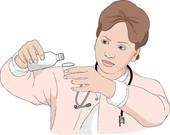 Ingestion: oral tablets/capsules: Oral Medications in Solid Form Ingestion: oral tablets/capsules: Oral Medications in Solid Form
- Appropriate positioning of a client, the elevation of the head the client should be sitting up or standing to take oral medications, not lying down.
- Place capsules or tablets for a client in medication or soufflé cups for administration. When pouring tablets/capsules, put on gloves or use the lid of the container to pour the medication, then drop the medication into a medicine cup. Avoid handling medications with fingers as you may accidentally damage or drop pills, use tweezers if necessary to move medications into the medicine cup. Other packaging options include but are not limited to blister packs and pre-filled ready medication packs.
- Administer powdered medications such as bulk laxatives with the number of fluids indicated;
- Offer client sufficient fluids following the administration of oral medications even if the medication is administered in a food substance or the medication is a liquid. Offer a drink of liquid before and after each medication. Use a straw if necessary.
- Observe the client taking the medication to assure the medication is swallowed before documenting the administration of the medications;
- For clients who have difficulty swallowing medications, the following techniques may be helpful to gain cooperation, as well as assist the client to take all medications:
– Offer tablets/capsules one at a time. If necessary, place the medication in the middle of the client’s mouth. Allow the client to rest a short time after each med (QUIETS THE COUGH REFLEX). Allow enough time for the client to take the medication.
– Some tablets or capsules may be easier to swallow if given in a teaspoon of jelly or applesauce if permitted on the client’s diet. Be sure to tell the client that there is medication in jelly or applesauce. You may not trick the client with disguises for meds. The physician must be consulted and an order written to add medications to food.
– Some clients request their medication to be crushed. Do not crush enteric-coated tablets. You may not crush or open any medication without a physician order approving this procedure. If the client has continued difficulty taking oral medications, report this to the person in charge of client care. The physician may need to be consulted. Many medications are available in another form.
– Remain with the client to be certain all oral medications have been swallowed. This also ensures that the medication is taken on time. In some instances, checking the client’s mouth may be indicated to verify swallowing the medication.
- Lozenges are not to be swallowed. Instruct the client to allow the medication to dissolve in the mouth. Drinking liquids should be avoided until the medication has completely dissolved. These medications should be given last after other oral medications.
|
 Ingestion: sublingual (sl) tablets: Sublingual Medications Ingestion: sublingual (sl) tablets: Sublingual Medications
- Place the medication under the client’s tongue in the front part of the mouth. If several medications are being given, give the sublingual tablet last.
- Instruct client not to chew or swallow the medication until the tablet is entirely dissolved
- Do not follow with liquid, which might cause the tablet to be swallowed
- Nitroglycerin SL tablets:
a) Instruct the client to sit down (NOT to lay down) upon the first indication of angina (chest pain), administer nitro SL and immediately notify your supervisor of the situation.
- Notify supervisor;
- Follow physician’s orders;
- Record the exact minute of administration on the MAR;
- Consult the client’s record to see if there is a physician order for aspirin to be given when chest pain occurs.
b) After one dose of nitro SL is given and chest pain is not relieved, you or your supervisor must follow facility procedures to provide prompt medical attention.
- Call 911 for paramedics and transport to an emergency room.
c) If chest pain resolves within 5 minutes, advise the client to sit for an additional 15-20 minutes to prevent dizziness or fainting. Headaches are a common side effect of the drug and should last no longer than 20 minutes. If headaches persist, notify the supervisor.
d) Be sure to tightly recap the nitro SL bottle
- Replace the medication supply every 6 months.
e) Stay with the client until chest pain is resolved.
|
 Ingestion: oral liquids and gargles: Liquids Ingestion: oral liquids and gargles: Liquids
- Never approximate the amount of medication to be administered, such as liquids;
- The amount ordered is to be the amount administered;
- Use a calibrated syringe for measuring liquids in amounts less than 5 ml and unequal amounts;
- When measuring liquids place the medication cup on a flat surface and measured at eye level to ensure accuracy for liquids, hold the medication container so that the medication flows from the side opposite the label so it doesn’t run down the container and stain or obscure label;
- Do not mix liquid medications together;
- Check to see that the cap of the bottle is securely. Remove the cap and place it with the open side up (top of the cap down);

- Locate the marking on the medication cup for the amount of medication to be poured;
- Pour immediately prior to administering, liquid medication may not sit for any length of time;
- Clean the lip of the bottle, if necessary, with a moist paper towel/tissue before recapping;
- Gargles are solutions that are bubbled in the throat by keeping the solution in the upper throat, tilting the head back and exhaling air to create bubbling. Check directions with gargles to know whether the medication should be diluted prior to administration;
- Measure liquid medications in a calibrated medication cup/device; never use eating utensils or other household devices for administering medications;

- Certain medications have special measuring devices for administering the medication; these measuring devices have increments marked off in mgs; instead of mls and usually have the name of the medication on the measuring device;
- Liquids may have administration requirements such as “Shake Well and Requires Dilution” prior to administration. Read instructions to determine if contents are to be shaken as with suspensions. A rotating wrist movement will ensure a more thorough mixture.
Examples of these liquids are Dilantin Suspension, which must be shaken thoroughly because the medication settles and gives inconsistent dosing; some liquids, i.e., liquid Potassium, must be mixed with sufficient fluids to decrease side effects.
|
 Ingestion: oral tablets/capsules: Oral Medications in Solid Form
Ingestion: oral tablets/capsules: Oral Medications in Solid Form
 Ingestion: sublingual (sl) tablets: Sublingual Medications
Ingestion: sublingual (sl) tablets: Sublingual Medications Ingestion: oral liquids and gargles: Liquids
Ingestion: oral liquids and gargles: Liquids
